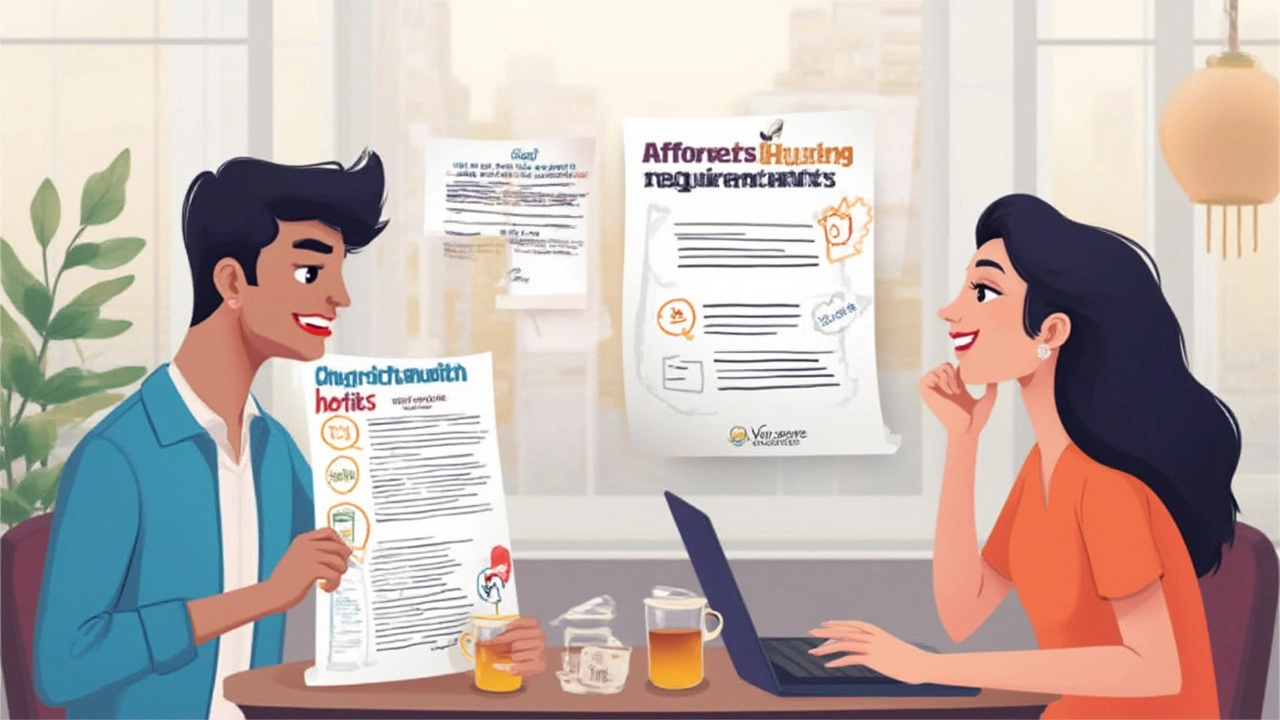Affordable Housing Eligibility in Fairfax County: Requirements, Facts & Application Guide

Jul, 22 2025
If you’ve spent more than a hot second looking for a place to live in Fairfax County, you've probably had sticker shock more than once. Rents keep climbing, and for plenty of people—nurses, teachers, gig workers, parents juggling two jobs—the dream of a decent apartment or townhome feels out of reach. But there’s this hope: Fairfax County’s affordable housing programs. The tricky part isn’t just finding them; it’s figuring out if you really qualify. Who updates these “income limits” anyway? And what counts as a household? Let’s cut through the confusion and look at what it actually takes to be eligible for affordable housing here, why it matters, and how to stack your odds of getting that yes.
Understanding Affordable Housing: Program Basics and Key Facts
The buzzword “affordable housing” gets tossed around a lot, but in Fairfax County, it actually means something pretty specific. It’s not just a vague promise—it’s a set of programs, like the Affordable Dwelling Unit (ADU) Rental and the Workforce Dwelling Unit (WDU) programs, aimed squarely at helping people who aren’t making some Silicon Valley salary but need to live and work right here. The backbone of these programs is the Area Median Income, or AMI. Each year, the county updates the AMI using stats from the U.S. Department of Housing and Urban Development (HUD). In 2025, for a family of four, the Fairfax County AMI is $152,600. That number shapes who can actually apply for affordable housing, and who gets left out.
When programs talk about “percentage of AMI,” they’re breaking it down like this: if your income is, say, 60% of the AMI for a household your size, you’d fall within the sweet spot for several affordable housing programs. Here’s a look at the most recent numbers:
| Household Size | 60% AMI | 80% AMI | 100% AMI |
|---|---|---|---|
| 1 | $57,540 | $76,720 | $95,900 |
| 2 | $65,760 | $87,680 | $109,600 |
| 3 | $73,980 | $98,640 | $123,300 |
| 4 | $82,200 | $109,600 | $137,000 |
| 5 | $88,776 | $118,368 | $147,960 |
If you’re raising your eyebrows at those numbers—yep, a family pulling in well over $80,000 can still qualify for many programs. Rents and mortgages are so high here, these ceilings aren’t as wild as they sound at first. What counts as income, though? Not just your base salary. Construction workers, retail staff, Uber drivers, contractors—if you’re hustling multiple jobs, everything gets counted. The county looks at pay stubs, benefits, side gig income, and money from anyone over 18 in your household, except for full-time students who aren’t head of household. Even child support and Social Security count.
There are a few myths out there. Some folks assume affordable housing is only for the unemployed or those facing deep poverty. That’s just not accurate. The whole point in Fairfax is to help working households bridge that gap between barely making rent and reasonably affording a decent spot. Affordable housing is built for folks who often earn too much for federal programs but not enough to handle market rates on their own.
If you want a hard fact, try this: according to the county’s own data from late 2024, about 30,000 households in Fairfax were spending more than half their income on rent or mortgage. That’s called being "cost burdened"—and if you’re nodding along, you’re not alone. The affordable housing programs are trying to change exactly that. To drive the point home, here’s a quote seen in a local report:
"Stable housing is the foundation for healthy communities. Fairfax County’s commitment is to keep that door open for all who contribute to our local economy." – Fairfax County Department of Housing & Community Development
Every program comes with its own quirks, but they all start with two things: residency and financial need. You need to either already live or work in Fairfax County—not just passing through—and your income must fit certain limits. For most programs, you can’t own any other residential property. Your assets—real estate, savings, anything you can liquidate—also get checked. No hiding extra homes under a relative’s name.
And here’s something a lot of people miss: there are programs for rental units and programs for purchasing homes at below-market rates. Even if buying feels like a pipe dream, it’s worth checking out these purchase options. The catch? The waitlist. It’s long, and it moves at the speed of bureaucracy. But tenants do get in. Persistence pays off.

Who Actually Qualifies? Drilling Down the Eligibility Criteria
So, you know your AMI math and you’ve checked your paychecks—now what? Let’s get specific about qualifications. The main types of programs in Fairfax County are:
- Affordable Dwelling Unit (ADU) Rental Program
- Workforce Dwelling Unit (WDU) Rental Program
- ADU for-sale program (below-market priced homes)
- Specialty programs for seniors or people with disabilities
All of these have base requirements. The first box to tick? Income. For most ADU rental apartments, your combined household income must usually fall between 50% and 70% of AMI. Workforce units bump that up, with some going as high as 100% AMI for bigger families. So if you’re a single parent with two kids and a $70,000 salary, you could be in the sweet spot for several options.
Next up, you need to have a stable household. That means everyone who’ll be living with you is counted, except foster kids (they aren’t included in the official household size calculation). If a relative or roommate will sign the lease and live there full-time, they count too. If your adult kids have jobs, their income gets factored in—even if you’re just letting them crash for a few years while they save up to move out.
Credit history doesn’t have to be spotless, but you can’t be evicted for cause in the past three years, and you can’t have unsatisfied rental judgments. Plus, you need documents for everything: pay stubs, tax returns, and proof of eligibility status for every adult. The county isn’t a bank—they know gig workers and freelancers have irregular income streams. They’ll look at annual averages, not just your latest deposit.
For homeowners hoping to get into the affordable for-sale program, you can’t currently own residential property. Your bank accounts, retirement savings, and investments are all checked. If you’ve got more than $70,000 in net assets (not counting retirement funds), you might not qualify. And a wild little fact—if you own a fancy car worth more than $40,000, it might get flagged as countable, too. Yes, really.
Citizenship or immigration status is a real consideration, too. You don’t have to be a US citizen, but you must have eligible immigration status. That’s green card holders, refugees, and a few other protected classes. And you do have to be in good standing—no ongoing legal troubles that would put your lease or mortgage at risk.
What about students and seniors? There are dedicated programs for seniors over 62 and adults with permanent disabilities, and these have slightly different asset and income rules. Seniors can use retirement income (pensions, Social Security), and families who care for a disabled family member may have additional deductions.
For rental programs, you’ll also have to meet occupancy standards—basically, not trying to squeeze too many people into a one-bedroom just because it’s cheaper. The county wants safety and quality—so you’d need an appropriate bedroom count for everyone in your household.
If you want a shortcut, here are the basic documents you’d need to gather for your application:
- Proof of income for all adults (pay stubs, benefit letters, gig receipts)
- Tax returns (at least two years)
- Identification (driver’s license or passport)
- Proof of Fairfax County employment or residency
- Asset statements (savings, investments, retirement)
- Immigration/citizenship papers (if not a citizen)
- Rental history or mortgage paperwork
I’ve got friends who’ve been through this grind, and the system won’t bite you for applying. The worst thing is just a longer wait. If you’re on multiple lists, you can jump at the first place that comes up—it’s not like picking a college.

Insider Tips for a Smoother Application—and a Fair Shot
Here’s where it gets personal. My spouse, Harper, and I tried to help Harper’s younger cousin get into an affordable apartment after her lease expired. She was just out of community college, working two jobs, and still couldn’t crack the rent here. What I learned from watching her navigate the system: the whole process looks complicated, but a few tricks make life easier.
First, timing is everything. Waitlists for popular properties get long fast. Starting your application right after the new AMI figures are published (usually each spring) can give you a jump—units are released in cycles, and early birds get their pick.
Next, keep your paperwork current and organized. Programs will ask for updated documents as you move up the list, not just when you first apply. If your income changes (up or down), report it immediately. Some people miss out by not updating their info, especially if a job layoff or cut happens after you applied.
If you hit a bump with the paperwork, don’t give up. County housing counselors are real people, and they run free briefings every couple months. Go. These folks know the quirks—like which units have flexible eligibility standards and how to speed up asset verification.
There are also “priority” categories. People who live or work in Fairfax get first dibs. If you’re a household with children, a senior over 62, or a person with a disability, you may get bumped higher up the list. Don’t be shy about noting any situations that could qualify you for preference. If you’re housing-insecure (couchsurfing, at risk of homelessness), bring it up. The county takes that seriously.
Here’s a quick step-by-step checklist for applying:
- Check your income and household size against the latest AMI chart.
- Gather tax returns, income documents, and proof of residency or local employment.
- Apply online or in person—keep track of your application number and status.
- Keep your info updated as your situation changes.
- Attend a housing briefing if you’re confused—these are free and genuinely helpful.
- Contact local nonprofits for help if needed. They’ll walk through the forms with you.
- Double-check your list rank from time to time, and respond quickly if a unit opens up.
Now, if you make it through the process and get an offer, pay attention to the fine print. Some affordable units have “recapture” rules if you buy, meaning if you sell the property in a few years, you won’t get to pocket the market surge profits. Don’t let that scare you—these homes still offer major security, and you can always move up to the private market later if things go well. Renting through these programs also often means stabilized rent and access to some free support services, from credit counseling to jumpstarting your next move.
One thing I wish more folks knew: affordable housing isn’t just a lifeline for people struggling—it’s a core part of making the entire county function. Teachers, EMTs, social workers, restaurant staff—when these folks can afford to live where they work, everyone benefits. The county’s own studies found that crime rates drop and neighborhoods get more stable when affordable housing is within reach. And with major projects like the Residences at Government Center and the new North Hill Community just completed, more options keep opening up.
So yes, keep your expectations realistic—the process is slow, but not impossible. With the right timing and a complete application, your odds of landing an affordable place in Fairfax County are better than you might think. And if you get stuck, reach out. The help is there—you just need to raise your hand and ask.